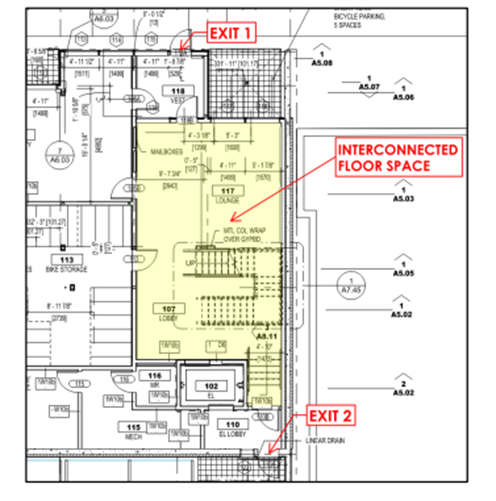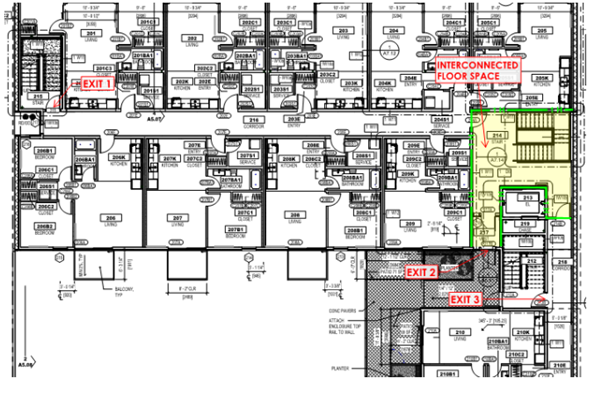BCAB 1902 - Corridor within an interconnected floor space
Corridor within an interconnected floor space
Project description
The project is a five-story mixed-use sprinklered building of combustible construction, 1259 m2 in building area. The upper four storeys of the building contain residential suites. The first storey is mixed use including residential suites, commercial units, storage areas, and lounge/amenity area.
There is an interconnected floor space area connecting the first and second storeys with an open stairway. The interconnected floor space on the first storey is primarily a lounge/lobby and amenity room.
The interconnected floor space on the second story is primarily an open stairway connecting with the first storey. Also included within the interconnected space is an “extension” of the public corridor serving the residential suites in the remainder of the floor area. It is necessary to pass through the interconnected space to access the second required exit for the residential suites on the second storey. The interconnected space is separated from the remainder of the second storey floor area by a vertical fire separation with a 1 hour fire resistance rating. The travel distance from any point in the second storey floor area to an exit is less than 45 m.

First Storey

Second Storey
Applicable Code requirements (BCBC 2018)
3.2.8.2. Exceptions to Special Protection
6) An interconnected floor space need not conform to the requirements of Articles 3.2.8.3. to 3.2.8.8., provided
a) it consists of the first storey and the storey next above or below it, but not both,
b) it is sprinklered throughout or, where the building area is not more than one half of the area permitted by Subsection 3.2.2., the openings through the floor are used only for stairways, escalators or moving walks (see Note A-3.2.8.2.(6)(b)), and
c) it contains only Group A, Division 1, 2 or 3, Group D, Group E, or Group F, Division 2 or 3 major occupancies (see Note A-3.2.8.2.(6)(c)).
1.4.1.2. Defined Terms (Division A)
1) The words and terms in italics in this Code shall have the following meanings:
Major occupancy means the principal occupancy for which a building or part thereof is used or intended to be used, and shall be deemed to include the subsidiary occupancies that are an integral part of the principal occupancy.
3.1.2.1. Classification of Buildings
1) Except as permitted by Articles 3.1.2.3. to 3.1.2.6., every building or part thereof shall be classified according to its major occupancy as belonging to one of the Groups or Divisions described in Table 3.1.2.1. (See Note A-3.1.2.1.(1).)
Decision being appealed (Local authority’s position)
The local authority acknowledges the interconnected space of the second storey is separated from the residential suites by a fire separation with a 1 hour fire resistance rating. However, as access by a public corridor to the required second exit for the residential suites passes through the interconnected space, the local authority considers the subject interconnected space to contain a Group C major occupancy.
Appellant's position
The appellant considers the exemption of Sentence 3.2.8.2.(6) is intended for interconnected floor spaces containing occupancies that are not separated from the interconnected floor space area with a vertical fire separation. Since the residential suites on the second floor are separated from the interconnected floor space with a 1 hour vertical fire separation, Group C occupancies are not considered to be contained within the interconnected floor space.
Appeal Board decision #1902
It is the determination of the Board that the subject interconnected floor space contains a Group C major occupancy.
Reason for decision
The exceptions to special protection in Sentence 3.2.8.2.(6) do not include Group C major occupancy. Based on the definition of major occupancy, the Board determined that the interconnected floor space contains a Group C major occupancy. Further Sentence 3.1.2.1.(1) requires every part of a building to be classified according to its major occupancy.
Lyle Kuhnert
Chair, Building Code Appeal Board
